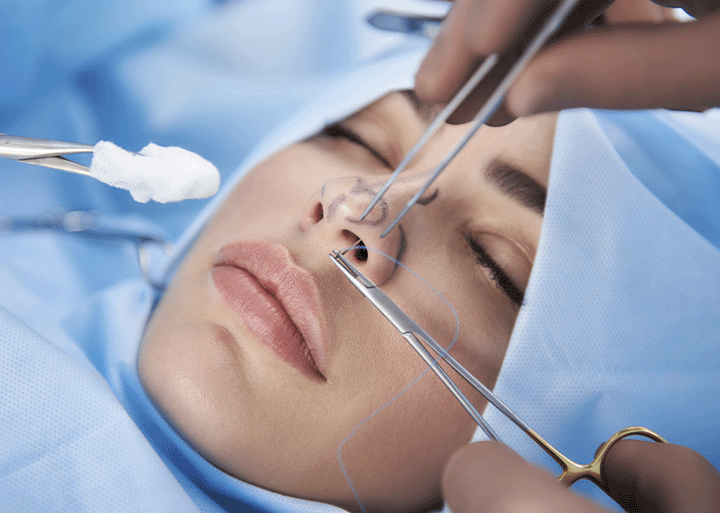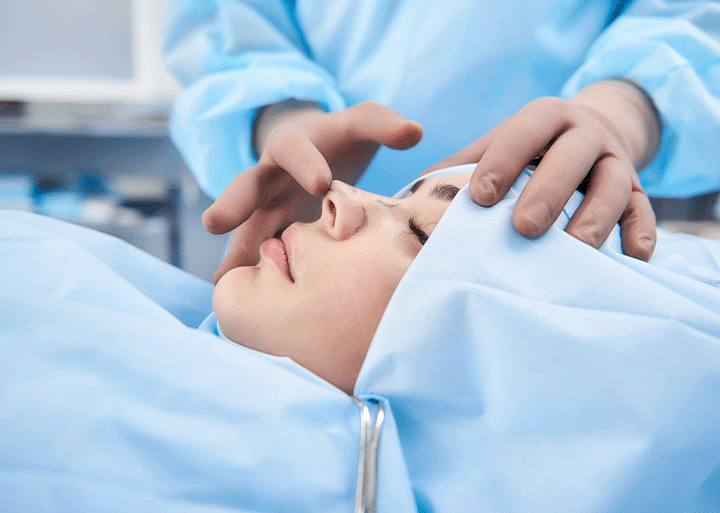
The nose is the central feature of the face and therefore the aim of rhinoplasty is always to achieve balance and proportion. There are many different types of Rhinoplasties for either medical or cosmetic purposes.
- Reduction Rhinoplasty: Commonly known as a Nose Job, Reduction Rhinoplasty is a plastic surgery procedure for correcting and reconstructing the form of the nose.
This type of rhinoplasty means that your nasal structure will be reduced. If your nose is too large, there is usually a lot of cartilage or thick skin in the area. Removing or sculpting the existing tissue gives your nose a better appearance.
- Augmentation Rhinoplasty: A cosmetic surgery procedure performed to increase the size of specific parts of a person’s nose to give it a more aesthetically pleasing appearance. This will give your nose a stronger profile so it will not droop. The cosmetic surgeon might use synthetic implants or grafts for this procedure. This procedure unlike others can add height to the nose bridge or alter the shape of the nasal tip to increase its projection.
- Post-Traumatic Rhinoplasty: The post-traumatic rhinoplasty surgery can address both the appearance and the functionality of the injured nose. Post-traumatic patients usually suffer a broken nose. This is usually a result of injuries, car accidents, and fights. If a patient has a serious nose injury, s/he may have to wait at least six months or even a year before undergoing extensive surgery.
- Reconstructive Rhinoplasty: Following a surgery to remove cancer or occasionally following facial trauma, the nose may be left severely disfigured due to the lack of tissue that has been removed or lost. Whether the nasal deformity is a result of cancer surgery or a traumatic accident, this often requires reshaping the nose replacing missing skin and cartilaginous support tissue. Surgical repair requires the use of grafts and flaps from various parts of the body to restore the missing component tissues.
- Ethnic Rhinoplasty: Technically, any rhinoplasty can be considered an ethnic rhinoplasty as every patient belongs to one or more ethnicity. Ethnic Rhinoplasty procedures involve special considerations because the nose should match the rest of the face, providing the improvements and enhancements sought in the nose. For patients of African, Asian, Middle Eastern and all other ethnic descents, the goal is improving their appearance without diminishing their ethnicity. Briefly a nasal surgery where the nose is surgically altered to create a symmetrical, aesthetically pleasing nose that suits the patient’s face without diminishing the patient’s ethnic characteristics.
- Refinement Rhinoplasty: Refinement Rhinoplasty is one of the most common forms of rhinoplasty. Many patients are unhappy with the way their nose points up or down at the tip, how bulbous or round the tip appears, or how pointy the tip is. Your surgeon may add or remove cartilage and tissue in order to perfect the tip’s shape or direction. Tip refinement can be a better choice when you want to avoid extensive nose surgery.
- Revision Rhinoplasty: People may become dissatisfied with their rhinoplasty results for several reasons. Revision rhinoplasty is a surgical procedure that revises or corrects the results of a previous surgery.
- Septoplasty: The septum is the cartilage that divides the nose into two nostrils. Most people with a deviated septum have one nasal passage that’s much smaller than the other. This can cause difficulty in breathing. Septoplasty is a surgical procedure that’s performed to fix a deviated nasal septum.
- Turbinoplasty: Turbinates and Upper Respiratory System turbinates are the bony structures on either side of the nose. These turbinates warm, humidify and purify the air that we breathe. Turbinates are structures along the side wall of the nose that can swell and cause obstruction. Anything that reduces the size of the turbinates to help you breathe better is termed a “turbinoplasty.”
- Alarplasty: The alar is the section of the nose where the nostrils become rounded and extend toward the cheek. Some patients find the wide nostrils and/or the flaring of the nostrils to be distracting. An alarplasty adjusts the size and shape of the nostrils by removing a predetermined amount of the soft tissue.




